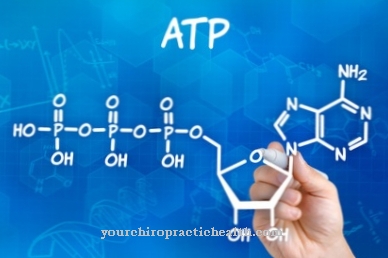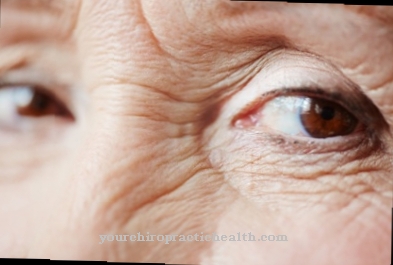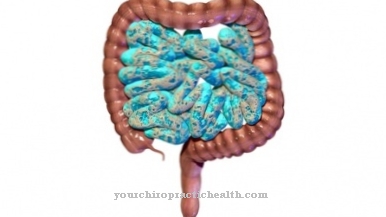The Feel is a sensory quality that lets people feel objects or subjects on the basis of active exploration. The haptic perception differs from tactile perception, which corresponds to passive skin perception. Multisensory integration disorders, neurological diseases and receptor diseases disrupt haptic perception.
What is haptic perception?

The human skin senses have different qualities. The passive qualities are summarized under the term of tactile perception for the sense of touch. Tactile perception is made up of protopathic and epicritical perception and thus consists of the passive temperature sensation, the passive pain sensation and the passive sensation of touch.
However, human skin also has the ability to perceive the qualities of objects and living beings through active exploration. This active exploration is summarized under the term haptics. The term goes back to Max Desoir, who coined the term in the 19th century.
Haptics encompass both interoception and exteroception, i.e. the active perception of stimuli on the body surface as well as the active stimulus perception from inside the body.
Biophysiologically, the basis of tactile and haptic perception is made up of the somatosensory and the sensorimotor system. Haptics encompass pain perception in the sense of nociception, temperature perception in the sense of thermal reception and haptic surface sensitivity in the sense of the perception of mechanical stimuli as pressure, vibration and tissue stretching.
Haptics also includes proprioception as depth sensitivity or the ability to perceive one's own body position in space. In addition, kinesthesia and visceroception are often included in the haptics.
Function & task
Haptics allow people to perceive object properties such as size, weight, contour, material properties, strength and temperature of a subject or object. Different receptors or sensory cells are involved in haptic perception. The mechanoreceptors of the skin are just as important as the stretching, pressure and vibration receptors in the tendons, joints and muscles. The haptic system integrates this information into a common perception.
In the individual layers of the skin there are up to 600 million receptors, for example the Vater-Pacini corpuscles for vibration stimuli, the Meissner corpuscles for pressure changes, the Merkel cells for sustained pressure stimuli and the Ruffini corpuscles for tissue stretching or the Golgi tendon organs and the muscle spindles.
The body hair is also equipped with around 50 touch receptors for registering deformations. In addition to mechanical stimuli, the free nerve endings in the epidermis perceive temperature and pain stimuli.
In contrast to other sensory perceptions, the integration of multiple receptors plays a major role in haptic perception. The information from the mechano- and proprioreceptors travel via afferent sensory pathways of the spinal cord through the thalamus into the cerebral cortex. In the thalamus, a connection takes place via the nucleus ventralis posterior. The resident neurons project directly into the secondary and primary somatosensory parts of the two contralateral halves of the cerebral cortex.
From there, the cortical processing has afferents to the parietal lobe and to secondary somatosensory regions. The projection continues at this point to temporal parietal areas, the frontal temporal association cortices and the islet cortex. The task of the neurons in the posterior parietal cortex is the multisensory integration of the haptic information. They form the basis for cognition. Connections to the temporal lobe ensure the memory of touch. Efferent signals travel via neural connections with subcortical and cortical regions in the parietal lobe.
There are differences for the tactile and haptic stimulation of sensory cells. With haptic perception, unlike tactile perception, there is always an activity in the motor cortex.
Illnesses & ailments
Because the haptics depends to a large extent on the integration of the multisensory information, a disruption of these integration processes can be associated with a generally disturbed haptic perception. Sensory integration disorders impair the interpretation of and the reaction to certain stimuli. As a result, those affected seem to behave inappropriately and can, for example, exert too much or too little pressure when touching objects or people. Haptic overactivity is highly likely to be inherited and, thanks to modern therapies, can be treated in the area of multi-sensory integration.
Even after lesions in the posterior parietal cortex, there may be an inability to haptic integration. Such lesions can be caused, for example, by ischemia, by strokes or neurological diseases such as multiple sclerosis.
The haptics can also be disturbed independently of the multi-sensory integration processes. This can be the case with damage to the afferent nerve tracts in the spinal cord. Damage to all other haptically relevant regions of the central nervous system can also be the cause of disturbed haptics.
Depending on the location of the lesion, for example, the haptic memory can be disturbed. Incorrect tactile information caused by the lesion is also conceivable, as could be the result of restricted surface sensitivity.
Receptor-related diseases are rather rare in this context, but can cause the impaired surface sensitivity as well as neuronal diseases. Receptor disorders are often associated with poisoning.
Much more frequently, however, abnormal sensations of the haptics are associated with peripheral or central nervous damage. Peripheral nerve damage can occur, for example, as part of a polyneuropathy and in this case are associated with vitamin deficiency, alcohol abuse, diabetes, toxins or cancer and infectious diseases.
There are accordingly many possible reasons for haptic perception disorders. The diagnosis of a specific disease therefore turns out to be extremely challenging in this context.













.jpg)

.jpg)
.jpg)











.jpg)